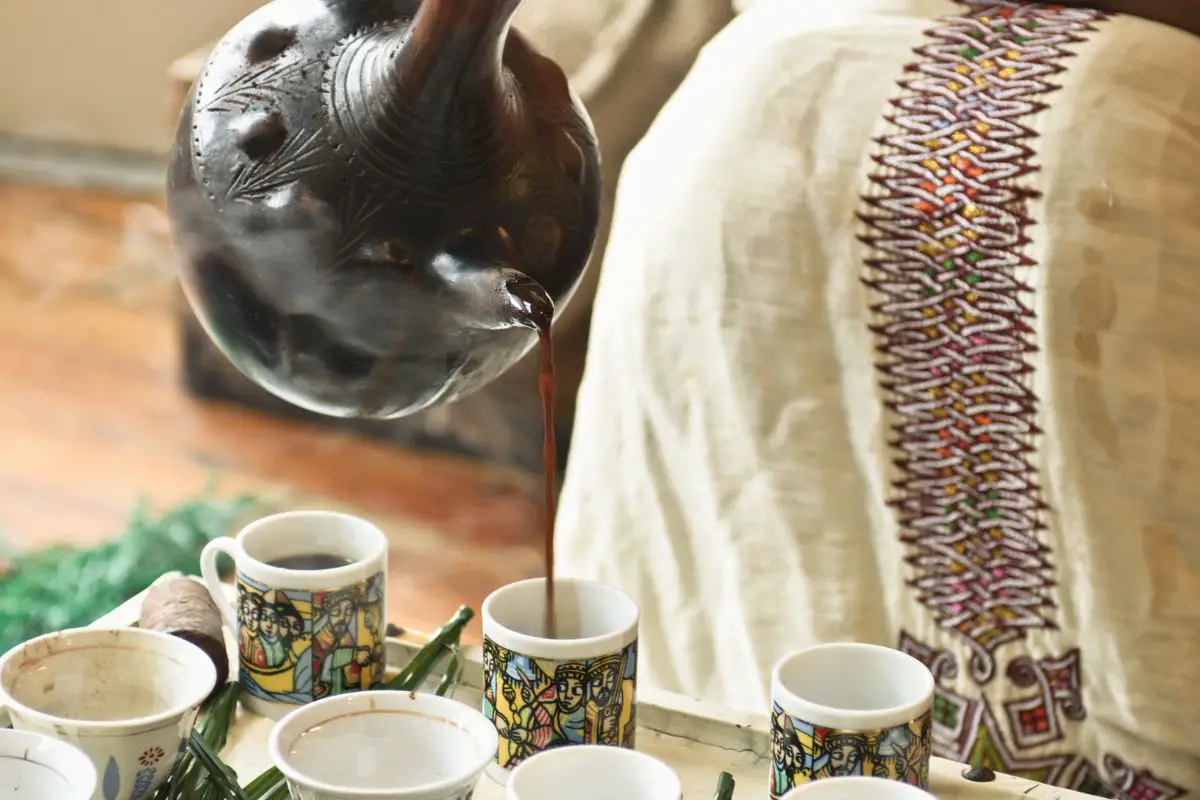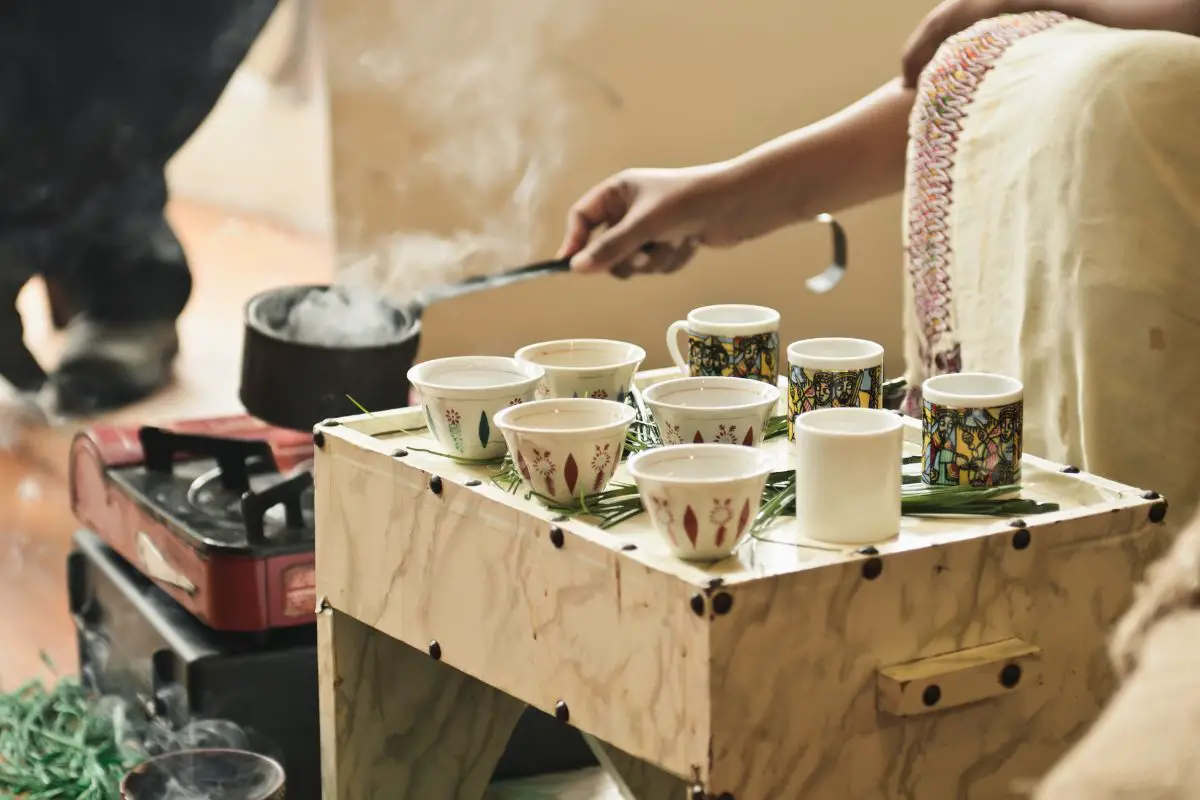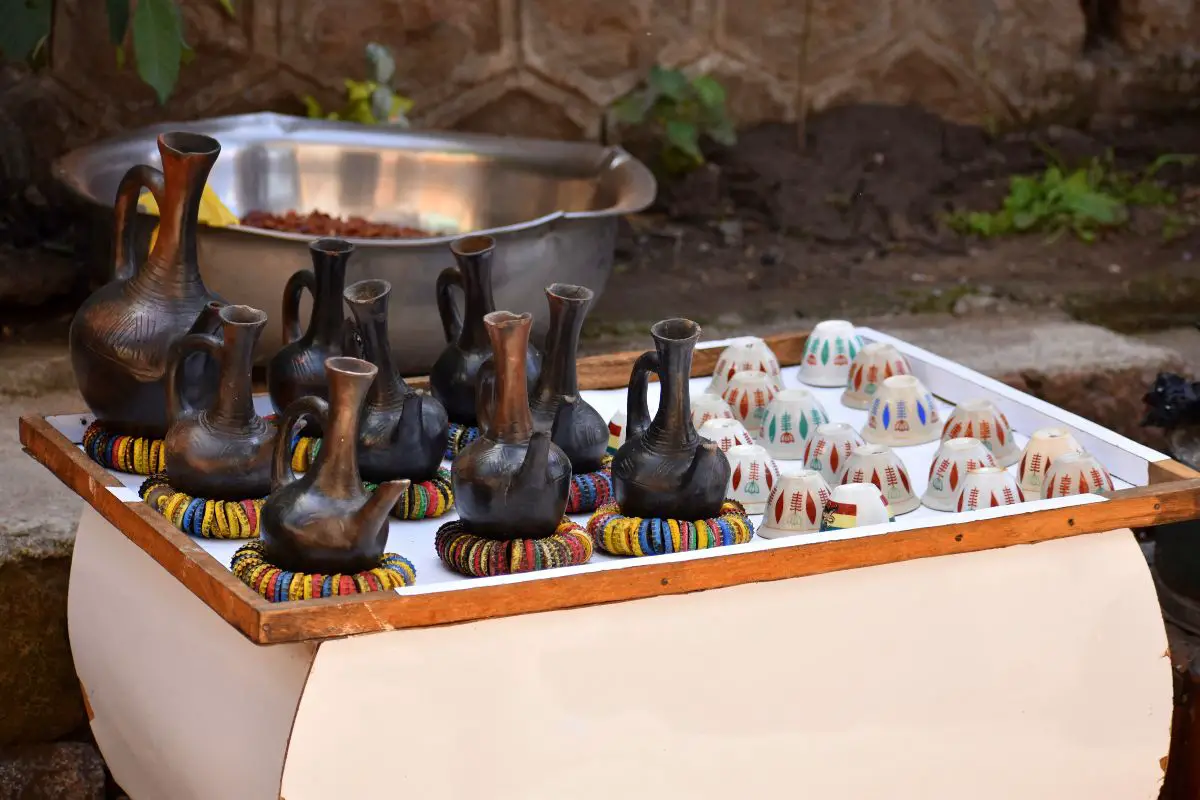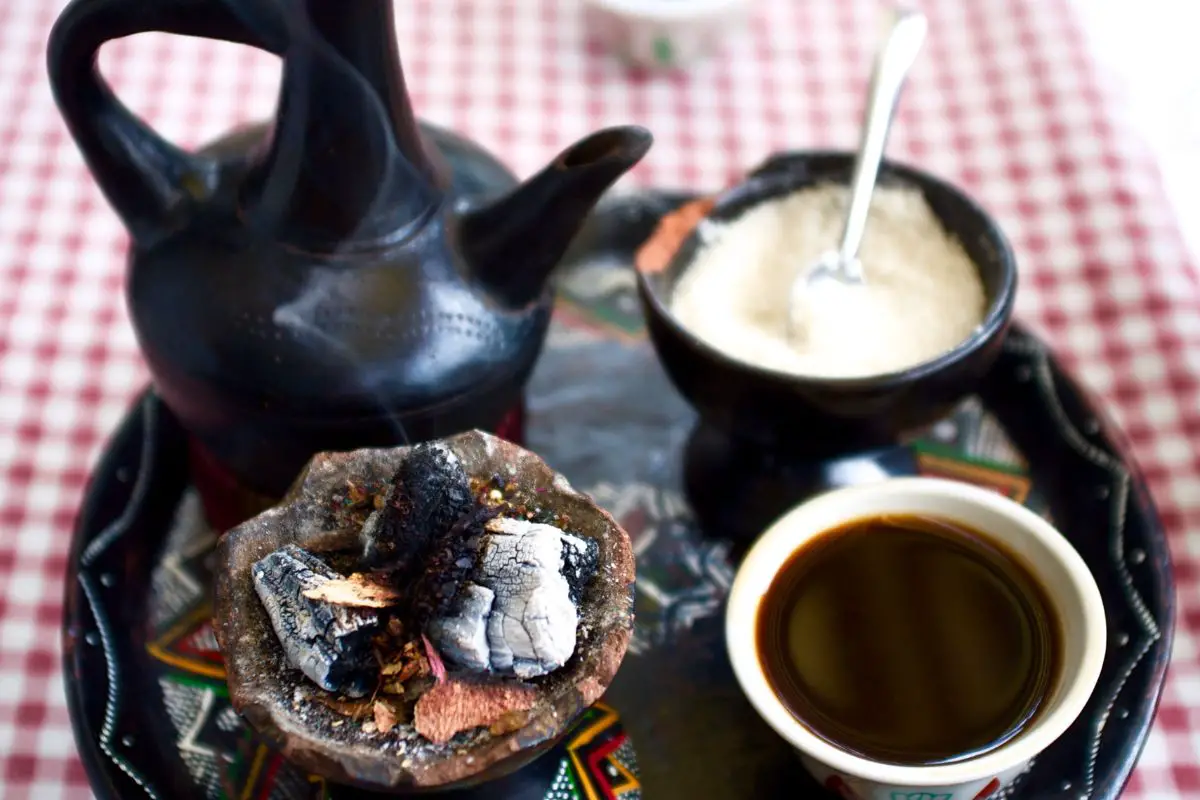Dive into the rich history and cultural significance of the Ethiopian coffee ceremony, which has been an essential social event in Ethiopia for centuries. Gain insight into the unique attire and accessories worn by both men and women during this important gathering, including shawls, traditional dresses, and jewelry. Discover how clothing and accessories used during the ceremony are carefully selected to represent hospitality, community, and preservation of cultural traditions. Finally, explore the modern adaptations and variations of the Ethiopian coffee ceremony attire, as it evolves over time to incorporate western fashion trends and becomes increasingly popular beyond Ethiopian communities.

Overview of Ethiopian Coffee Ceremony
The Ethiopian coffee ceremony is an integral part of the country’s social and cultural life. As the birthplace of coffee, Ethiopia takes immense pride in its coffee culture, and the ceremony serves as both a mark of respect and hospitality to guests. This traditional ritual involves the preparation and consumption of coffee in a communal setting, which aims to promote conversation and enhance social bonds among participants. In this article, we will explore the historical background and significance of the coffee ceremony in Ethiopia, and delve into the key components and procedure of this unique and cherished custom.
Historical Background and Significance
Ethiopia is believed to be the birthplace of coffee, with the discovery of the coffee plant dating back to the 9th century in the Kaffa region. The story goes that a goat herder named Kaldi noticed his goats became very energetic after eating berries from a certain plant. Curious, he tried the berries himself and experienced the same effect. He shared his discovery with a local monastery, and soon the word spread about these magical beans.
The origin of the Ethiopian coffee ceremony can be traced back to centuries-old traditions that have been passed down through generations. The ceremony holds a significant place in the social fabric of Ethiopia, symbolizing hospitality, friendship, and respect for guests. It is also a vital aspect of Ethiopia’s business culture, as local merchants often conduct coffee ceremonies to strengthen relations and finalize agreements.
In many aspects, the coffee ceremony serves as a symbol of unity and harmony among Ethiopians, bringing together people from all walks of life. It is a time-honored tradition that transcends religious, ethnic, and social boundaries, reflecting the strong sense of community inherent in Ethiopian society.
Key Components and Procedure
The Ethiopian coffee ceremony involves several key components and follows a specific procedure. Here are the main elements that make up the ceremony:
- Roasting the beans: The process begins with the host, usually a woman, selecting high-quality, green coffee beans and cleaning them carefully. The beans are then roasted on a flat iron pan over an open flame, while the host stirs the beans using a wooden spatula until they reach the desired color and aroma. The roasting process is an essential part of the ceremony, as it allows participants to appreciate the rich scent of the coffee beans.
- Grinding the beans: Once the beans are roasted to the desired level, they are left to cool down for a few moments. The host then grinds the roasted beans using a mortar and pestle, producing a fine powder. The rhythmic pounding of the beans adds another sensory experience to the ceremony, evoking a sense of anticipation among the guests.
- Brewing the coffee: The host then adds the ground coffee to a traditional Ethiopian clay coffee pot called “jebena,” along with water. The jebena is placed on a bed of hot coals or an open flame, and the coffee is brought to a boil. The brewing process requires skill and attention, as the coffee must be brought to a boil three times before it is ready to be served.
- Serving the coffee: The host pours the brewed coffee into small cups known as “sini” or “cini.” The pouring process is an art in itself, as the host must pour the coffee from a high distance without spilling it. The strong, aromatic coffee is typically served with sugar or salt and is often accompanied by snacks such as popcorn, peanuts, or traditional Ethiopian bread known as “ambasha.”
The Ethiopian coffee ceremony is not just about consuming coffee; it also provides an opportunity for participants to engage in conversation, catch up on local news, and even resolve disputes. The ceremony can last for hours, with multiple servings of coffee, and embodies the Ethiopian spirit of hospitality, togetherness, and the value placed on human connections. As such, it stands as a proud symbol of Ethiopia’s rich cultural heritage and enduring coffee tradition.
Ethiopian Traditional Attire
Ethiopian traditional attire is a reflection of the country’s rich cultural heritage, and it varies from region to region. The unique garments, made from locally sourced materials, not only serve a practical purpose but also hold cultural significance. The traditional clothing usually features vibrant colors, intricate patterns, and distinctive embroidery. These traditional attire can be seen during weddings, religious celebrations, and other special occasions. Let’s take a closer look at some of the key elements of Ethiopian traditional clothing for both men and women.
Men’s Attire
Men’s traditional attire in Ethiopia mainly consists of three types of garments – shemma or gabi, kuta, and netela. These garments are typically made from handwoven cotton fabric, and the designs can vary depending on the region and the weaver’s expertise.
Shemma or Gabi: Traditional Shawl or Cloth
Shemma, also known as gabi, is a type of shawl worn by men in Ethiopia. It is made of white cotton fabric and can serve as either a shawl or a blanket. Shemma is usually worn draped over the shoulders and wrapped around the body. In some regions, men may use a brightly colored shemma with elaborate embroidered patterns. Gabi can be worn with or without an accompanying kuta or other traditional attire and is a versatile garment used for both casual and formal occasions.
Kuta: Lightweight Shawl
Kuta is another type of shawl traditional to Ethiopia, made of lightweight cotton fabric. It is typically worn by men and can come in various colors and patterns, but white kuta with intricate embroidery is common for special occasions. The kuta is usually worn over the shoulders and wrapped around the body, often paired with a shemma or gabi for added warmth and style. Additionally, some men may wear the kuta as a headscarf, especially during religious ceremonies.
Netela: Women’s Shawl or Headscarf
While the netela is primarily known as a women’s shawl or headscarf, it can also be used by men in some regions of Ethiopia. The netela features a unique design, often with a border of delicate embroidery, and it is generally made of lightweight cotton fabric. For men, the netela can be worn as a headscarf or used to cover the shoulders during religious ceremonies. This versatile garment symbolizes modesty and respect in Ethiopian culture.
Women’s Attire
Ethiopian women’s traditional attire is comprised of several unique elements, including the kemis, tilf, and various headgear and hairstyles. Like men’s attire, women’s clothing is typically made from handwoven cotton fabric, and the designs are often intricate and eye-catching.
Kemis: Traditional Dress
The kemis is the mainstay of Ethiopian women’s traditional attire. It is a floor-length dress that is usually made of white or bright-colored cotton fabric. The kemis features a fitted bodice and a flowy skirt, making it a comfortable and elegant option for various occasions. The borders of the dress, especially the neckline and hem, may feature intricate embroidery and patterns. Traditional kemis designs vary by region, with each community showcasing its unique artistic flair.
Tilf: Traditional Jewelry
Ethiopian women often accessorize their traditional attire with tilf, which includes a range of jewelry made from gold or silver. These pieces highlight the intricate craftsmanship and artistry that Ethiopia is famous for, often featuring elaborate designs with religious or cultural significance. Some popular types of tilf include necklaces, bracelets, earrings, and anklets. Additionally, women may wear traditional belts called chelots around their waist to accentuate their kemis and add a touch of elegance.
Headgear and Hairstyles
Headgear and hairstyles play an essential role in Ethiopian women’s traditional attire, as they complement the overall look and showcase the individual’s sense of style. The netela is a common headscarf worn by women, usually draped over the head and shoulders or wrapped around the head in a turban-like style. It is made from lightweight cotton fabric and adorned with intricate embroidery, adding a touch of grace and sophistication to the look.
Traditional Ethiopian hairstyles are another important aspect of women’s attire. These hairstyles, such as the shuruba and dabo, serve as an expression of cultural identity and often hold symbolic meanings. For instance, some hairstyles are reserved for married women or indicate a person’s social status. Typically, Ethiopian hairstyles are intricate and eye-catching, often featuring tight braids and designs that require a considerable amount of time and skill to create.
In conclusion, Ethiopian traditional attire showcases the richness of the country’s culture and the skills of its artisans. These garments, made from locally-sourced materials and adorned with intricate patterns and embroidery, reflect the unique artistic expression of the Ethiopian people. From men’s shemma and kuta to women’s kemis and tilf, each piece holds a special place in the Ethiopian cultural landscape, making these garments more than just clothing, but symbols of pride and heritage.
The Attire and Accessories Specific to the Coffee Ceremony

Traditional Clothing for the Hostess
The Ethiopian coffee ceremony is a cultural tradition that’s often held during special occasions, holidays, and gatherings. It’s important for the hostess to be dressed in traditional attire while conducting the ceremony. The attire includes a special kemis, which is a white dress with colorful embroidered borders, and a netela, a white shawl with colorfully embroidered edges. Both of these clothing items contribute to the warmth and authenticity of the coffee ceremony.
Special Kemis for Coffee Ceremony
A unique feature about the Ethiopian coffee ceremony is the requirement for the hostess to wear a traditional dress called kemis. This long, flowy dress is usually white in color and is made out of a cotton fabric called shemma. The key feature of the kemis is the colorful handwoven embroidery on the borders, which is called tibeb. This intricate design adds a touch of elegance to the dress and represents the rich cultural heritage of Ethiopia.
These dresses can be found in various styles and designs, as each region of Ethiopia has its own traditional pattern for the tibeb. The embroidery can be found along the neckline, sleeves, and hemline of the dress. The kemis worn during the coffee ceremony not only adds a level of formality to the event but also showcases the hostess’s connection to her culture and traditions.
Role of Netela
Another vital component of the hostess’s attire is the netela. This lightweight shawl is made from a soft, handwoven cotton fabric and is used to cover the hostess’s shoulders and head during the ceremony. It signifies modesty and respect while also adding a touch of elegance to the overall ensemble.
The netela is also adorned with colorful embroidery along its borders, similar to the tibeb on the kemis. This intricate design makes the netela a visually captivating part of the traditional attire. Additionally, the netela can be used to hold the roasted coffee beans while the hostess walks around the room, allowing guests to take in the aroma.
Traditional Accessories Used During the Ceremony
Along with the attire, there are several traditional accessories used during the coffee ceremony that play an essential role in the whole process. These accessories include the jebena (coffee pot), ceni (small clay cups), rekebot (serving tray), and mukecha (traditional coffee grinder).
Jebena: Ethiopian Coffee Pot
The jebena is a unique coffee pot made from clay and is used to boil and serve the coffee during the ceremony. It has a round base, a long neck, and a spout where the coffee is poured out. A straw lid is often placed on top of the jebena to keep the coffee warm. The jebena serves as a symbol of Ethiopian tradition as it showcases the country’s unique, time-honored method of brewing coffee.
Ceni: Small Clay Cups
Ceni are the small clay cups used to serve coffee during the ceremony. They are traditionally made from clay and are characterized by their small size, which allows the guests to slowly savor the strong and flavorful Ethiopian coffee. Often, these cups are decorated with various traditional patterns and designs, adding a touch of beauty and cultural richness to the serving process.
Rekebot: Serving Tray
The rekebot is the serving tray used during the coffee ceremony. It is often made of wood, with a platform to hold the cups and jebena, and legs that keep it easily accessible at a comfortable height for the hostess. The rekebot plays a critical role in the ceremony, as it is used to display the coffee and cups, allowing the hostess to move around the room and serve her guests efficiently.
Mukecha: Traditional Coffee Grinder
Finally, the mukecha is the traditional coffee grinder used during the Ethiopian coffee ceremony. It consists of a wooden mortar and pestle that is utilized to grind the roasted coffee beans into powder. The use of the mukecha showcases the manual, labor-intensive process involved in preparing coffee, emphasizing the value and appreciation for the art of coffee making in Ethiopian culture.
Symbolism and Cultural Importance of Clothing and Accessories
Clothing and accessories have long been an essential part of human civilization. They serve a variety of purposes, ranging from providing protection and warmth to highlighting and enhancing the individual’s appearance. However, clothing and accessories go far beyond their practical purposes; they play an essential role in conveying cultural, religious, or social messages. In this article, we will explore the symbolism and cultural significance of clothing and accessories in different societies, detailing aspects related to community, hospitality, preservation of traditions, and the artistic expression behind them.
Community and Hospitality
The clothes and accessories people wear are often a reflection of their cultural background, religious beliefs, or social status. This symbolism enables people to quickly identify and connect with members of their community, facilitating communication and promoting hospitality among its members. For example, wearing traditional clothes such as a Japanese kimono, Indian sari, or African dashiki helps to strengthen the bond within the community, celebrating cultural identity and a shared heritage.
Moreover, clothing and accessories are also vital in demonstrating respect and hospitality towards others outside of one’s community. Dressing appropriately when attending a religious event, wedding, or business meeting demonstrates an awareness and understanding of the host’s cultural expectations. In certain societies, traditional clothing is even considered a sign of politeness when visiting a foreign country or participating in an international event. Such acts of hospitality further the mutual respect and understanding between different cultures.
Preservation of Cultural and Family Traditions
Many traditional clothing items and accessories serve as a means of preserving cultural and family traditions passed down through generations. In some indigenous communities, for example, clothing is handcrafted, with patterns and styles reflecting specific family lines, clans or tribes. This ancestral knowledge is often passed down through storytelling, ensuring that the younger generation understands the cultural significance behind the clothing they wear.
Another example is the wearing of heirlooms, such as a piece of jewelry passed down through several generations. These items of adornment carry with them a sense of pride and continuity, linking the wearer to their family history and cultural legacy. Passing down such heirlooms also fosters a stronger connection to one’s ancestors, keeping alive the memories and stories associated with these objects.
Emphasis on Artistic and Design Elements

Clothing and accessories serve as an artistic canvas for various societies to showcase their creativity, craftsmanship, and cultural expression. Clothing items often feature intricate embroidery, unique fabric patterns, or elaborate color combinations, reflecting the aesthetic sensibilities and design preferences of the cultures that produce them.
One example of such artistic expression is the Indian sari, which is known for its elaborate patterns and vibrant colors. The intricate art of weaving or hand-painting delicate designs on these fabrics showcases the rich tradition and creativity of Indian textiles.
Another example can be found in the distinctive geometric patterns of traditional African clothing. These patterns often carry symbolic meanings, representing elements of nature, important events, or human experiences. The unique patterns and bold colors used in African fashion serve as a source of inspiration for contemporary fashion designers worldwide.
In conclusion, clothing and accessories hold deep cultural significance, serving as more than just a means of protection or adornment. Through their symbolic meanings, they bring communities together, promote hospitality and understanding between cultures, preserve family and cultural traditions, and showcase the artistic creativity and craftsmanship of their creators. It is essential to recognize and cherish the individuality and richness of each culture’s unique expression through its clothing and accessories, as these elements contribute significantly to the diverse and vibrant tapestry of global culture.
Modern Adaptations and Variations in Ethiopian Coffee Ceremony Attire
As Ethiopia’s cultural significance continues to grow on a global scale, the traditional attire worn for coffee ceremonies has experienced numerous adaptations and variations. Modern influences are evident in the way the Ethiopian coffee ceremony attire has evolved, yet the core elements that are intrinsically linked to Ethiopia’s customs and traditions remain. This article will discuss the impact of Western fashion trends on Ethiopian coffee ceremony attire, the incorporation of traditional components in modern designs, and the increasing recognition of Ethiopian coffee rituals beyond ethnic boundaries.
Influence of Western Fashion Trends
The traditional attire worn by Ethiopians during coffee ceremonies has long comprised a combination of white, woven cotton garments known as shamma and netela. However, the influence of Western fashion trends has led to a more diversified approach in the design and styling of these ceremonial cloths. One notable transformation is the addition of patterns and embroidery, inspired in part by the aesthetics of European or American fashion.
Another example is the growing popularity of blending Ethiopian traditional attire with Western clothing items, such as denim jackets and trench coats. These hybrid outfits marry the heritage and history of the Ethiopian coffee ceremony with the contemporary appeal of global fashion trends. Moreover, social media platforms have played an essential role in disseminating cultural conversations surrounding Ethiopian attire, further integrating Western and Ethiopian fashion styles.
Influence from Western fashion trends has also led to increased choice and variety in materials and construction. Synthetics and blended fabrics are now commonly found alongside traditional cotton textiles, offering more budget-friendly options and allowing for experimentation with texture, color, and form.
Incorporation of Traditional Elements in Contemporary Designs
While the influence of Western fashion trends has introduced new styles and techniques to Ethiopian coffee ceremony attire, contemporary designers have not lost sight of the rich traditional symbolism woven into the fabric of these garments. Many modern adaptations still incorporate traditional elements such as intricate embroidery patterns, emphasizing the cultural significance and meaning behind these designs. Other elements such as symbolism, religious imagery, and regional motifs are also preserved in contemporary interpretations.
There is a growing trend for local designers to blend traditional techniques with modern production methods, especially regarding the use of digital technology. From 3D printing to computer-aided design (CAD), Ethiopian designers are experimenting with innovative ways to create unique, contemporary clothing while preserving the timeless beauty of their cultural heritage.
Additionally, the eco-friendly aspect of traditional Ethiopian textiles is attracting global attention, as there is often an emphasis on sustainability and using locally sourced, natural materials. This has further highlighted the appeal of incorporating traditional elements into modern Ethiopian coffee ceremony attire.
Increasing Popularity of Ethiopian Coffee Ceremonies Beyond Ethnic Boundaries

Ethiopian coffee culture, complete with its attire, is becoming increasingly popular beyond Ethiopian communities. Across the western world, interest in Ethiopian customs and traditions has led to a growing demand for authentic coffee ceremony experiences.
As more people from diverse ethnic backgrounds participate in these events and seek to honor the ritual’s cultural significance, this global interest has expanded the adaptability of Ethiopian coffee ceremony attire. Different ethnic groups and cultures are now able to incorporate their unique fashion expressions while adhering to the core principles and aesthetics of traditional Ethiopian clothing.
This growing appreciation and acknowledgment of Ethiopian coffee ceremonies from a global perspective have resulted in a rapid evolution of coffee ceremony attire. With continuous adaptation and innovation, Ethiopian coffee ceremony dress now represents a unique blend of the old and the new, with traditions being preserved while embracing contemporary influences.
FAQs on Traditional Ethiopian Coffee Ceremony Attire and Accessories
1. What is the traditional attire worn during an Ethiopian coffee ceremony?
Traditional Ethiopian attire for a coffee ceremony typically consists of a white cotton dress known as a “Habesha Kemis” for women and a white shirt with matching pants called “gabi” for men. Both outfits feature colorful handwoven details and embroidery for a festive appearance.
2. What is the significance of wearing traditional attire during an Ethiopian coffee ceremony?
Wearing traditional attire during an Ethiopian coffee ceremony symbolizes respect for the cultural practice and helps create a sense of unity and connection among participants. The clothing’s intricate designs and handmade nature also represent the detailed focus and artistry involved in the coffee-making process.
3. How is the traditional attire made and what fabrics are utilized?
Traditional Ethiopian attire is crafted from a locally sourced, lightweight cotton fabric known as “shemma.” Shemma is woven into long strips, which are then sewn together to create the garment. Handwoven patterns and embroidery accents are added for a unique, culturally significant appearance.
4. Are traditional accessories commonly worn or used in an Ethiopian coffee ceremony?
Yes, traditional accessories often accompany the attire during an Ethiopian coffee ceremony. These can include a “netela,” a handwoven shawl worn by women, and the “kuta,” a similar fabric used as a blanket or shawl by men. Additionally, unique jewelry like beaded necklaces and bracelets may be worn by female participants.
5. Is it necessary for attendees to wear traditional attire during an Ethiopian coffee ceremony, especially if they are not Ethiopian?
While it is not mandatory for non-Ethiopian individuals to wear traditional attire during a coffee ceremony, donning the appropriate clothing can demonstrate an appreciation for and understanding of Ethiopian customs. When attending such events, it is always best to inquire about expected attire in advance and follow the guidance provided.
6. Where can one purchase traditional Ethiopian attire for a coffee ceremony?
Traditional Ethiopian attire and accessories can be found for purchase online through specialized retailers or marketplaces, as well as at local Ethiopian stores or community centers. It may also be possible to find these items in major cities with sizable Ethiopian populations or during cultural events or festivals.